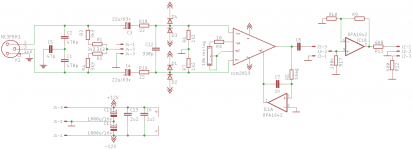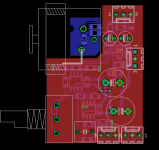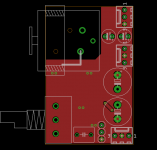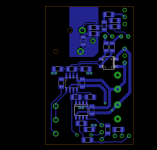I needed a small cheap mic preamp to add an input for a project and I was surprised to find very few kits for that (at a reasonable price at least). So I decided to roll my own. It's a bit overkill for my current application but I wanted something I could re-use later on.
It's a mix of datasheets for the ina217-ssm2019-that1512. It has provisions for phantom power and a volume control in between the ssm2019 and the output if desired.
Values for c8-r9-r10 depend on application.
PCB size is 5*3.5cm. All connectors molex kk.
I'll order the pcb soon. So if anyone has corrections to suggest, I'll gladly listen.
It's a mix of datasheets for the ina217-ssm2019-that1512. It has provisions for phantom power and a volume control in between the ssm2019 and the output if desired.
Values for c8-r9-r10 depend on application.
PCB size is 5*3.5cm. All connectors molex kk.
I'll order the pcb soon. So if anyone has corrections to suggest, I'll gladly listen.
Attachments
I needed a small cheap mic preamp to add an input for a project
The servo capacitor seems very small, should be more like 1uF nonpolar.
Also, the servo inputs are swapped.
Last edited:
100nf at the very least. And good catch on the inputs. Going too quickly through mirroring and rotating the part.
You always have to watch the pinouts carefully when not using a rats nest.
Why use a servo and C8? If the servo works, C8 should not be needed. Also, is the diode bridge really an MB15? That's an absolutely gargantuan part, and it'd dominate the distortion of the entire circuit. Some smaller diodes would make more sense. Of course, I might have read the part number wrong!
Finally, the 600Ω output resistor is not useful. It just adds cable rolloff problems for no good reason - nobody needs 600Ω sources, and if an ancient device does need one, build out the normal 50-100Ω source to 600 right at its input. Use a 50Ω output series R instead, just to keep the op amp happily isolated from capacitive loads, while allowing the output to be multed without level problems.
Finally, the 600Ω output resistor is not useful. It just adds cable rolloff problems for no good reason - nobody needs 600Ω sources, and if an ancient device does need one, build out the normal 50-100Ω source to 600 right at its input. Use a 50Ω output series R instead, just to keep the op amp happily isolated from capacitive loads, while allowing the output to be multed without level problems.
Last edited:
Not sure what your budget is, Expat Audio hae a pre built version for $60
Eden Microphone Preamplifier | expataudio
Hope this helps
Peter
Eden Microphone Preamplifier | expataudio
Hope this helps
Peter
- An mb15 wouldn't fit ;-) It's a mb1s, a small soic4 0.5A diode bridge but with good surge ratings. There are some that app notes showing how 1n4148 aren't sufficient in that position.
- C8 can be replaced with a wire link easily. It's a bit of a "belt and suspender" safety thing.
- Agreed for the output resistor. Force of habit on that one.
- The expat audio preamp isn't too bad but it has things I don't need (the drv134 for example) and don't have things I'd like (pcb mounted xlr and pot, input filtering, possibility of a two stage gain-volume control). Budget-wise, my cart at mouser comes at 15€ for everything. Add 20€ for 10 pcb. Let's say 20€ total per preamp (shipping included).
- C8 can be replaced with a wire link easily. It's a bit of a "belt and suspender" safety thing.
- Agreed for the output resistor. Force of habit on that one.
- The expat audio preamp isn't too bad but it has things I don't need (the drv134 for example) and don't have things I'd like (pcb mounted xlr and pot, input filtering, possibility of a two stage gain-volume control). Budget-wise, my cart at mouser comes at 15€ for everything. Add 20€ for 10 pcb. Let's say 20€ total per preamp (shipping included).
Last edited:
Hello, guys!
Sorry for beginner's question - what if I need to use an electret condenser microphone? How would the circuit change?
If you mean working with just the capsule changes will be needed. If you're using a commercial electret mic with an XLR connector, just plug it in. The mic may require phantom power but that should be it.
G²
If you mean working with just the capsule changes will be needed. If you're using a commercial electret mic with an XLR connector, just plug it in. The mic may require phantom power but that should be it.
G²
I need it to work with the capsule. I won't need XLR at all.
This is not the right kind of circuit for you then. For an electret capsule on
a very short run of shielded cable, you better use a simple 1-opamp job
The Doz blog circuit has the feedback resistors connected wrong.
R5 should be connected to the other end of R4.
Last edited:
It's hard to ignore the simplicity and performance of Colin Mitchell's design just one BC547 transistor, 2 capacitors and three resistors and electret mic capsule, seen here: http://www.talkingelectronics.com/projects/14 FM Bugs/20 FM BUGS.pdf
With all these circuits my concern is gain - I will need it to be very high for my application. I need this preamp to be connected to Raspberry Pi and it should "hear" the lowest signal possible. Then I'll have to figure out how to make an ADC and make it work with RPi. That's the goal.
It's hard to ignore the simplicity and performance of Colin Mitchell's design just one BC547 transistor, 2 capacitors and three resistors and electret mic capsule, seen here: http://www.talkingelectronics.com/projects/14 FM Bugs/20 FM BUGS.pdf
Oh, thank you for the book! I've never heard of it... Well, obviously, as I've just started
That's right. It did look a bit funny... Silly mistakes like that could really trip up a novice.The Doz blog circuit has the feedback resistors connected wrong.
R5 should be connected to the other end of R4.
Did you say make an ADC?With all these circuits my concern is gain - I will need it to be very high for my application. I need this preamp to be connected to Raspberry Pi and it should "hear" the lowest signal possible. Then I'll have to figure out how to make an ADC and make it work with RPi. That's the goal.
I think you sort of have your approach backwards. You say you need "very high" gain, but it seems you have little idea what that means. 30 dB? 40 dB? 60 dB? 80 dB? And what is "the lowest signal possible"?
The usual approach for this would be as follows:
1. Determine required noise level in dB SPL. Choose capsule to deliver this performance. (Note, if you need less than about 30 dB SPL(A) you're generally SOL with small electret capsules. A Proper Microphone will be required then. Besides, you'll have to determine what kind of microphone directionality you need. An omni capsule will do you no good when what you actually need is a highly directional shotgun mic, and vice versa. Note that some mic types have become so inexpensive that they are better bought off the shelf - like a basic cardioid large diaphragm condenser.)
2. Determine resulting output noise level from mic effective noise level and mic sensitivity. (Note: Some interaction with amplifier input impedance is expected. If a standard electret capsule with JFET in common source is spec'd into a bias resistor of 2k2 from 3 V or so, 6k8 from 9 V will net you 10 dB higher sensitivity. So there's some leeway here. The same does not apply to capsules with a source follower output.)
3. Determine ADC / line input effective noise level from full-scale input level and input dynamic range. (A device with a built-in preamp may make your life easier.)
This will, after some dB juggling, give you the information required to determine what sort of effective input noise and gain you will need on your preamplifier. And then, finally, you will be able to decide on a topology. (Spoiler alert: You'll probably end up with at least a 2-transistor job like P13. Trying to wring more than 20-30 dB or so from a single transistor is really asking for trouble.)
If as a novice you have trouble with the maff, you could just dump all the relevant information you have here and have someone else figure it out for you. Maybe in a new thread with an explanation of what you are intending to accomplish.
- Home
- Source & Line
- Analog Line Level
- Small mic preamp




